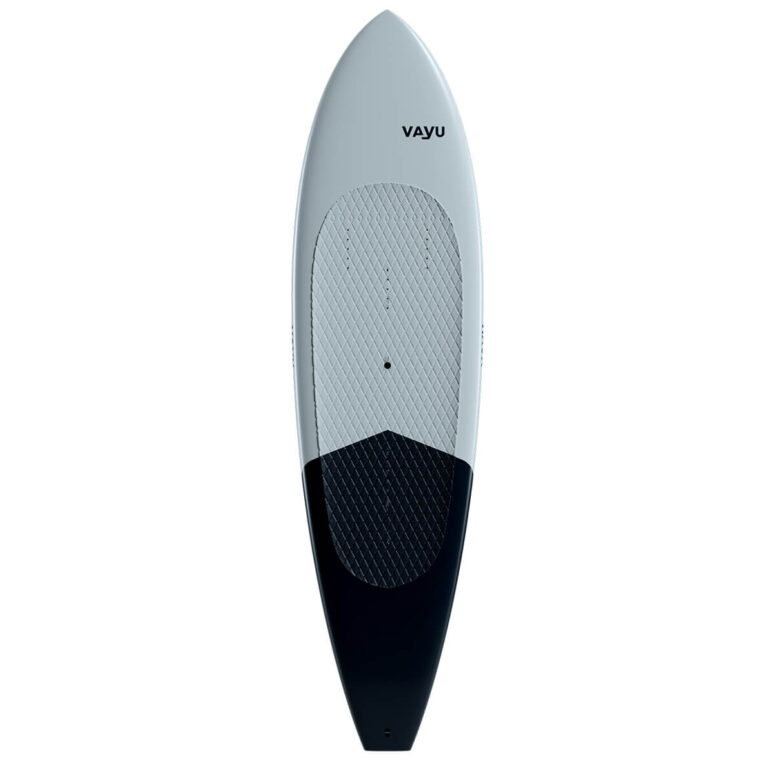

When you purchase gear through links on our site, we may earn a small commission. Here’s why you can trust our tests and our affiliate partner.

In the last few months, there has been great hype around downwind foiling with tons of shapers introducing new, slender boards conceived to reduce drag and make it easier to achieve foil take-off speeds, whether it is with paddling, or winging as in this case.
Vayu introduced the Edge Wing as a cutting-edge wingfoil early glide board that promises to redefine the standards of performance and innovation in light winds. I recently had the opportunity to put my hands on this highly promising early glide board in its 6’5 size, with 85 liters of volume – and I simply loved it. The board's design, at a glance, immediately declares its light wind aspirations – the most evident feature being its long and narrow waterline and its extended tail shape derived from the most advanced downwind foil boards.
On the water, the Edge Wing truly shines with its early glide capabilities. The long tail concept adds a crucial increment of board speed that allows it to take off in lighter winds than expected. In fact, the board’s ease of taking off is nothing short of impressive, allowing riders to harness minimal wind conditions while still retaining great responsiveness to rider input. Both the board outline and its volume distribution mimic the ones of a much shorter board, ensuring a dynamic and controlled experience while flying, pumping or maneuvering, with a short nose that causes less swing momentum. The Edge Wing agility is further enhanced by the lightweight construction.
Crafted with a high-quality carbon fiber sandwich layup wrapped around an EPS core with a PVC layer in a multi-step vacuum process, the Edge Wing strikes an optimal balance between durability and weight. The nice lightweight construction renders the experience of pumping the board out of the water effortless: you don’t feel the added length as the construction is truly top notch. Moreover, the reduced drag resistance allowed by the long and narrow tail makes it very easy to get back up on the foil after an accidental touchdown. This is further underscored by the carefully designed rocker line, enhancing board speed during take-off and reducing drag after touchdowns.
Versatility is a key highlight; the board caters to both intermediate and advanced riders and while it is specifically designed for light wind conditions, it behaves very well even when the wind picks up. Its adaptability, stemming from a thoughtful design focused on early planing capabilities, provides enough forgiveness for those learning the ropes of early take offs on the foil (given that they adapt to the reduced stability of the narrow outline while standing on the board without flying) while accommodating the demands of seasoned riders seeking ease of take off combined with precision and speed during flight. In a few words: it’s a board that helps you take-off in light winds without hinderance when you are already up on the foil or when the wind picks up. In this sense, it not only met but surpassed the expectations I had for an early glide board: it simply added more versatility and range than a traditional wing board by allowing for earlier take-offs without compromising maneuverability and control during flight and transitions.
With its 6'5 length and 85 liters, the size I tested felt nicely balanced for my weight (85kgs). The Edge emerges as a compelling choice, for both heavier riders like me looking for a board capable of providing a solid platform to master the art of light wind wingfoiling but also even possibly for lightweight skilled riders looking for a board to bridge wingfoiling and SUP downwind foiling.
In conclusion, the Vayu Edge Wing is a testament to the brand's commitment to innovation and performance. This wingfoil early glide board sets a new standard in take-offs and pumping capabilities and deserves serious consideration for those looking to extend their time on the water on light wind days. Vayu's meticulous craftsmanship and attention to detail have undoubtedly resulted in a board that not only meets but exceeds the expectations of riders across skill levels.
